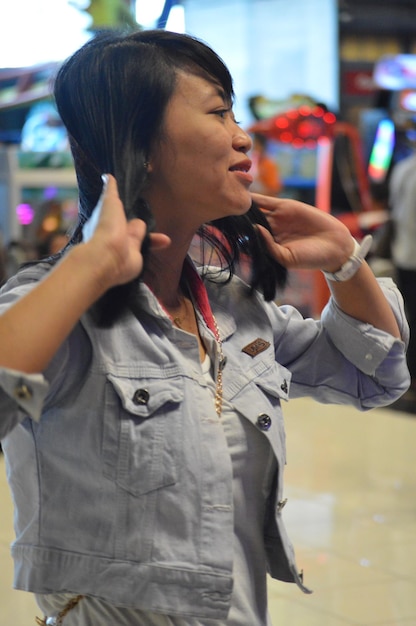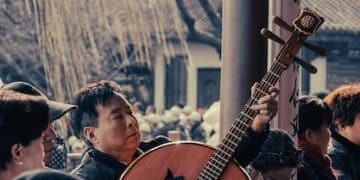Unveiling K-Pop Vocal Techniques: A Guide for Fans

K-Pop vocal techniques blend stylistic elements with rigorous training, creating the distinctive sounds of artists like BTS and BLACKPINK; appreciating these complex methods unlocks a deeper understanding of their artistic value and overall performance.
Dive into the captivating world of K-Pop and explore the intricate vocal techniques that set its artists apart. From powerful belting to delicate harmonies, understanding these nuances enhances your appreciation for the music.
Understanding K-Pop Vocal Foundations
K-Pop’s vocal landscape is a fusion of global influences and disciplined training. It’s important to understand the basics to truly appreciate the artistry involved. This section explores the groundwork upon which K-Pop vocal techniques are built.
The Importance of Vocal Training
Before diving into specific techniques, we must appreciate the rigorous training K-Pop idols undergo. This includes breath control, vocal exercises, and stylistic coaching.
Influences on K-Pop Vocals
K-Pop draws influences from various genres, including R&B, pop, and even classical music, blending them into a unique vocal style.
- Breath control is essential for sustained notes and powerful delivery.
- Vocal exercises improve range, agility, and tone quality.
- Stylistic coaching helps artists develop their unique vocal color.
In essence, the foundations of K-Pop vocals are built upon a strong technical base, fused with a unique blend of international music styles, resulting in versatile and captivating vocal deliveries.

Identifying Power Vocals: Belting and Projection
Power vocals are a staple in K-Pop, characterized by strong projection and impactful delivery. Belting and projection are two key techniques in this domain. Here’s how to identify and appreciate them.
The Mechanics of Belting
Belting involves singing high notes with the chest voice, creating a powerful and resonant sound. It requires precise breath control and vocal cord coordination.
Understanding Vocal Projection
Projection is about ensuring the voice carries effectively without strain. This is achieved through proper breath support and resonance.
- Listen for notes that are sustained and powerful without sounding strained.
- Observe how the vocalist uses their entire body to support the sound.
- Note the consistent tone quality even at high volumes.
Power vocals in K-Pop utilize a combination of belting and projection to create impactful performances. These techniques demonstrate both strength and control, captivating audiences with their dynamic delivery.
Exploring Delicate Techniques: Falsetto and Head Voice
Not all K-Pop vocals are about power; delicate techniques like falsetto and head voice are equally important. These techniques add contrast and emotional depth to performances. Let’s explore how they are used.
Differentiating Falsetto from Head Voice
Falsetto is a breathy, airy sound produced by using only the edges of the vocal cords. Head voice is fuller and more resonant, using more of the vocal cords.
Falsetto and head voice often add emotion to songs, providing contrast from the vocalists chest voice.
These techniques allow for intricate harmonies and delicate melodies, showcasing the versatility of K-Pop vocalists.

Mastering Riffs and Runs: Vocal Agility in K-Pop
Vocal agility is a hallmark of many K-Pop vocalists, demonstrated through impressive riffs and runs. These techniques require precision and control. Let’s look at how they enhance performances.
Defining Riffs and Runs
Riffs are short melodic patterns, while runs are longer, more complex sequences. Both are executed with speed and accuracy.
Factors Affecting Vocal Agility
Various factors affect a vocalist’s vocal agility, including talent, practice, and technique.”
- Listen for quick, seamless transitions between notes.
- Note how the vocalist maintains clarity and pitch even at fast speeds.
- Observe the use of ornamentation to add flair and personality.
Riffs and runs showcase the technical skill and musicality of K-Pop vocalists. They add excitement and intricacy to songs, making performances more dynamic and engaging.
The Art of Vocal Color and Tone
Vocal color and tone are subjective qualities that define a singer’s unique sound. They are essential for creating distinct identities within a group. Understanding these aspects enriches the listening experience.
What Defines Vocal Color?
Vocal color refers to the unique timbre or quality of a singer’s voice. It’s influenced by vocal cord anatomy, resonance, and stylistic choices.
The tone of the song, style, and genre affect how the vocalist approaches a song.
Recognizing the nuances of vocal color and tone allows fans to connect more deeply with the artistry of K-Pop vocalists.
Harmonies and Vocal Layering in K-Pop
Harmonies and vocal layering are crucial for creating rich and complex textures in K-Pop songs. These techniques add depth and emotional impact to the music. Here’s how they are effectively used.
Creating Harmonic Textures
Harmonies involve multiple vocalists singing different pitches that complement each other. This creates a fuller, more resonant sound.
Vocal layering is a common technique in the making of audio for K-Pop recordings.
- Listen for how the harmonies blend together to create a unified sound.
- Note the emotional impact of the harmonies on the overall song.
- Observe how vocal layering adds depth and complexity to the arrangement.
Harmonies and vocal layering are essential tools for creating rich, emotionally resonant K-Pop songs. They demonstrate the collaborative nature of K-Pop and significantly enhance the listening experience.
| Key Concept | Brief Description |
|---|---|
| 🎤 Vocal Training | Foundation for all techniques; includes breath control and exercises. |
| 🗣️ Belting & Projection | Power vocals using chest voice and ensuring clear sound delivery. |
| ✨ Falsetto & Head Voice | Delicate techniques adding emotional depth and contrast. |
| 🎶 Harmonies & Layering | Combining voices to create rich, complex sound textures. |
Frequently Asked Questions
▼
Belting involves a specific vocal technique that allows singers to hit high notes with power, resonating from the chest voice without straining the throat. Singing loudly without proper technique can be harmful and lack the rich resonance of belting.
▼
Breath control is essential because it allows vocalists to sustain long notes, maintain consistent vocal quality, and execute complex vocal runs and riffs. It provides the necessary support for powerful and agile performances.
▼
Unique vocal color develops through a combination of natural vocal characteristics, intensive training, and stylistic choices. Artists work closely with vocal coaches to refine their individual sound and expressiveness.
▼
While professional K-Pop vocalists undergo extensive training, many of the basic techniques can be learned by anyone. Consistent practice, proper guidance, and dedication are key to improving vocal skills.
▼
Harmonies add depth, richness, and emotional complexity to K-Pop songs. Properly executed harmonies can elevate a song’s overall impact, creating a more immersive and captivating listening experience for the audience.
Conclusion
Understanding and appreciating the intricate vocal techniques within K-Pop allows fans to connect more deeply with the music and artistry. Now equipped with the knowledge of belting, falsetto, harmonies, and vocal color, you can delve into the nuances that make each K-Pop act unique, enriching your listening experience and furthering appreciation for this global phenomenon.





